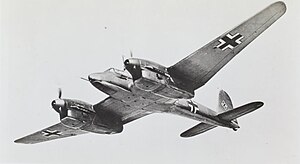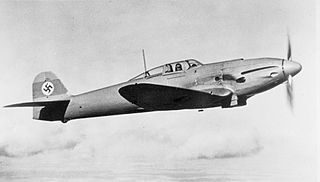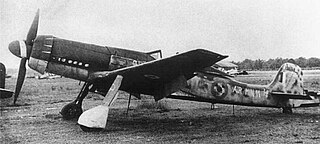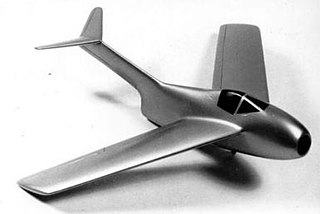Design and development
In the early to mid-1930s, developments in airframe design outstripped available aircraft engine power, allowing large aircraft to be built that existing engines were unable to sufficiently lift or propel (at least not alone). A period ensued in which multi-engine designs mostly outperformed aircraft designed with just one engine. In air racing in Europe, the Dornier Do 17 - a military design concealed under the guise of civilian use - outran every single-engine fighter it competed against. In Nazi Germany, this led to the idea of the " schnellbomber ", fast bombers that were expected to fly right past the defensive fighters. Although this period of twin-engine superiority would be short-lived, it also led to many air forces considering twin-engine fighter designs.
In 1935, Kurt Tank made the suggestion of creating a long-range single-seat fighter under a private venture within Focke-Wulf. The idea was not to produce a heavy fighter or bomber destroyer like the Bf 110, but instead a long-range design that would have the performance of a single-seat design. Powered by the new 736 kW (1,000 PS) Daimler-Benz DB 600, it had an expected speed of 560 km/h (350 mph). The design was unveiled in 1936 at an exhibition of new weapons, prototypes and projects held at the Henschel factory at Berlin-Schönefeld, where it was viewed by a number of high-ranking Nazi officials, including Hitler. However, the Reich Air Ministry (RLM) rejected the design on the grounds that the single-engine Bf 109 had comparable performance but would cost roughly half as much. The need for a long-range design was not considered serious, as at the time it was believed bomber escort was simply not needed.
Prototypes
Tank then took the design directly to Wolfram von Richthofen, chief of the development section of the Technischen Amt, the research and development arm of the RLM. Richthofen was not so convinced that bomber performance would remain superior to fighters, and gave the go-ahead for the construction of three prototypes, but on the condition that they replace the DB 600, which was in extremely short supply, with the less-powerful 515 kW (700 PS) Junkers Jumo 210.
R. Blaser was assigned to detail design. In order to improve performance compared to the Bf 110, the fuselage was made as small as possible, so small that there was no room on the instrument panel for the complete set of engine instruments, some of which were instead moved to the inside faces of the engine nacelles, as would also be done for the Henschel Hs 129 ground attack aircraft and some versions of the Bf 110. The engine nacelles were relatively normal, including both the engine and the main landing gear storage, but the front-mounted radiators for the engines were retractable for high speed when less frontal area would be needed to get the same airflow (an idea which was in some vogue at the time, and also used in the French Morane-Saulnier M.S.406). The mainwheels were fully retractable and faired and the design of the wing and tailplane required no struts or supports (unlike some late 1930s designs, such as early Bf 109s), in order to further reduce drag. The wing's two spars passed under the pilot's seat. As was common on pre-war designs, the line of the rear fuselage flowed straight into the line of the canopy, which created less drag than a bubble canopy, but also blocked direct viewing to the rear, although there were cutouts in the rear fuselage and the rear section of the canopy, which opened rearward and upward at an angle of about 15°, extended some ways to the rear to provide a degree of vision over the pilot's shoulder, if not directly rearward (the forward section of the canopy, over the pilot himself, hinged forwards in an unusual fashion). Although the cockpit was located well forward, a small window panel was fitted in the underside of the nose by the pilot's feet to improve the view for landing.
The first prototype, Fw 187 V1 (D-AANA), flew for the first time in late spring 1937, with Hans Sander at its controls. In testing it demonstrated a speed of 523 km/h (325 mph) despite the use of the low-powered Jumo engines; 80 km/h (50 mph) faster than the contemporary Jumo-powered Messerschmitt Bf 109B, despite having twice the range, more than twice the weight, and using two of the same engines. Members of the RLM complained that this was due to faulty flight instruments, but further testing ruled this out. The Fw 187's climb and dive rates were also on par - if not superior - to the single-seater.
Several changes were made to the design as a result of the testing, including new DVL propellers in place of the original Junkers-Hamiltons, and experimental twin-wheel bogies that were abandoned after testing. Blaser was concerned about flutter in the rudder at high speed and had a weight fitted to reduce it but in testing this caused so much flutter it was torn off at high speed. A second prototype followed with fixed radiators rather than earlier retractable versions, a semi-retractable tailwheel, changes to the elevator, and a vertical stabilizer with reduced chord. The engine was also upgraded to the 210G version of the Jumo, featuring direct fuel injection which resulted in a significant increase in power. New ejector-type exhaust stacks also contributed to increased speed by directing engine exhaust to the rear. Fw 187 V2 started testing in the summer of 1937, but crashed on landing when part of the main landing gear failed, and V1 was destroyed on 14 May 1938 after a high-speed pass over the Bremen facilities when the pilot, Paul Bauer, pulled up too sharply at the end of the pass resulting in a stall that sent the aircraft spinning into the ground.
Two-seater prototypes
Ernst Udet had replaced von Richthofen in 1936. An influential proponent of high-speed monoplane fighters, he nonetheless demanded manoeuvrability and doubted twin-engine designs could ever fully compete with single-engine types. Nevertheless, he felt the performance of the aircraft warranted development as a potential replacement for the Bf 110 in the bomber destroyer role. Even before V1 flew, Tank had been instructed to convert the design to a two-seater for this role despite the requirement for a second crew member in this role being marginal. The first two prototypes were already at an advanced stage of construction at this point, so two-seater work began on the third prototype which had just begun construction.
Blaser adapted the design by stretching the fuselage slightly but the inclusion of a second crew member altered the center of gravity which demanded the engine nacelles be modified to correct changes to handling characteristics. A new extended-length cockpit "framed" canopy was added, but due to the high line of the fuselage there was no easy way to include defensive rear-facing armament, relegating the second crew member to the role of radio operator. It was intended the offensive armament be improved by replacing two 7.92 mm (.312 in) MG 17 machine guns with 20 mm MG FF cannons, although these were never actually fitted.
Fw 187 V3 (D-ORHP) flew in spring 1938, but it suffered a starboard engine fire during one of the initial test flights and damaged its main landing gear in the resulting forced landing. It was quickly repaired and returned to service.
Two additional two-seat prototypes, V4 (D-OSNP) and V5 (D-OTGN), followed in the summer and autumn of 1938 respectively. While also powered by the Jumo 210, their performance was disappointing and led to a decision that any advantages of the new type would not warrant the replacement of the existing Bf 110.
The final prototype, Fw 187 V6 (D-CINY), was more heavily modified, receiving the originally specified 736 kW (1,000 PS) DB 600 engines, as well as a new surface evaporative cooling system for reduced drag. First flown in early 1939 it proved to have serious cooling problems (in common with other designs using the system, like the Heinkel He 100) and suffered some skin buckling and distortion. Nevertheless, during a series of carefully timed and measured runs in October 1939, the Fw 187 V6 reached 634 km/h (395 mph) in level flight, making it the fastest fighter in Germany at the time.
Production run
A small production run of three Fw 187 A-0 followed in the summer of 1939, based upon the V3 prototype and using the Jumo 210G engines. The Luftwaffe, however, stated that without defensive armament the aircraft could not fulfill the Zerstörer role, and remained uninterested in the design. The three two-seat prototypes were returned to Focke-Wulf after testing at Rechlin. There was a brief study in the winter of 1942/43 as a night fighter, but the lack of room in the cockpit for radar equipment quickly eliminated it from contention. After rejecting the design, the RLM "recycled" their 8-187 airframe number to Junkers for their Junkers Ju 187 dive bomber prototype.
Tank nevertheless directed a series of studies based around new versions of the basic airframe in roles including dive bomber, night fighter, fighter-bomber, high-altitude interceptor (with greater wingspan and lengthened rear fuselage), among others. These designs explored a variety of engines including the Daimler-Benz DB 601, DB 605 and even the BMW 801 radial engine.
In time the Ta 154 Moskito resulted from the Luftwaffe requirement for a twin-engine heavy fighter like the Fw 187, but constructed from wood instead of light alloys but due to the different material and construction techniques Tank made no use of the Fw 187 work, instead having to design a completely new aircraft to meet this requirement.
Surviving Fw 187s were apparently used as flying test beds during this program.














